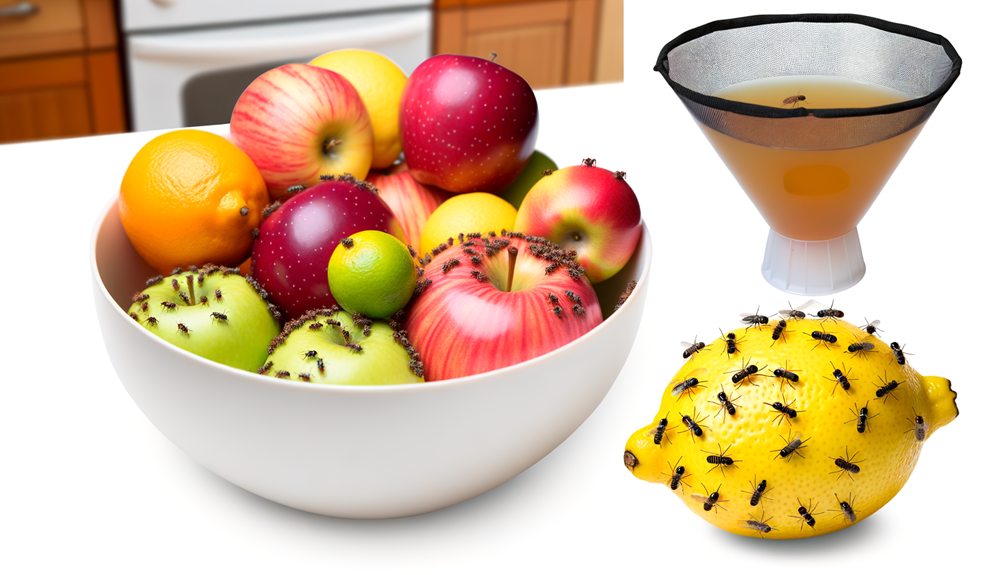Are you tired of those pesky fruit flies hijacking your kitchen? Imagine this: a single fruit fly can lay up to 500 eggs at a time, turning your peaceful kitchen into their bustling metropolis overnight. It sounds like a nightmare, right?
But don't worry—you're not alone in this battle. With the right strategies, you can reclaim your space. First, you need to understand how to identify these tiny invaders.
Then, you can explore effective DIY traps to drastically reduce their numbers. But here's the catch—are you missing a crucial step in keeping them at bay?
Let's dive into creating a home environment that's less inviting to these uninvited guests and discover straightforward methods to win back your kitchen.
Identify Fruit Flies
Recognizing fruit flies in your home is vital to tackle an infestation swiftly. These small pests, measuring about 1/8 inch (3 mm), have yellow-brown bodies and either red or black eyes. They're notorious for being attracted to ripe, overripe, or decaying fruits and vegetables, making kitchens and food storage areas common locations for infestations. You might notice clusters of adult flies buzzing around your kitchen bins or near overripe fruits.
To identify fruit flies accurately, distinguish them from similar pests like fungus gnats. Fungus gnats are typically pure black and often found near houseplants, unlike fruit flies.
Look for signs of their life cycle, which is remarkably fast, taking as little as 8-10 days from egg to adult. A single female can lay up to 500 eggs, leading to rapid population growth.
You might spot the larvae in decaying produce, an indicator of an infestation. Preventing and controlling these pests involves understanding what's attracting fruit flies to your space.
If you notice them, prompt action is critical to prevent them from overtaking your kitchen and other common areas where food is stored.
DIY Trap Methods
Once you've identified the presence of fruit flies in your home, it's time to take action with effective DIY trap methods. Tackling your fruit fly problem is straightforward with a few simple tools.
Start with the Apple Cider Vinegar Trap: grab a jar, fill it with vinegar, cover it with plastic wrap, and poke small holes. The vinegar's strong scent will attract the flies, and the dish soap added inside breaks the surface tension, guaranteeing the little bugs can't escape.
For a more sophisticated approach, consider a Funnel Trap. Roll a piece of paper into a cone and place it inside a jar filled with apple cider vinegar or rotting fruit. The funnel directs the flies in, but they can't find their way out, helping you eliminate fruit flies.
Another option is the Wine Trap. Pour leftover wine into a container with a drop of dish soap. The fermented scent draws in the flies, and the soap guarantees they're trapped.
Effective Baits
Choosing the right bait is essential for successfully trapping fruit flies. Your choice of bait can make or break your efforts in eliminating these pesky insects.
Apple cider vinegar is a top contender, known for its strong scent that irresistibly attracts fruit flies. Enhance its effectiveness by adding a drop of dish soap; this combination breaks the surface tension, causing the flies to drown.
Ripe banana peels are another powerful option. Their strong, sweet aroma is highly effective at attracting a considerable number of fruit flies, especially initially. Over time, however, strawberries take the lead as the most attractive bait after 24 hours, surpassing apples, which show no efficacy in experiments.
Fermented products like wine or beer also serve as effective baits. The natural scent of fermentation is something fruit flies can't resist. Wine vinegar, in particular, can be a valuable ally in your DIY methods for trapping fruit flies.
To summarize, when deciding on effective baits, consider apple cider vinegar with dish soap, ripe banana peels, and fermented products like wine vinegar. Each offers a unique advantage in your battle against fruit flies, ensuring your traps are successful.
Storebought Solutions
While homemade baits offer effective options for trapping fruit flies, storebought solutions provide a convenient and hassle-free alternative for immediate pest control.
With options like Terro Fruit Fly Traps, you can easily attract and capture those pesky fruit flies, giving you quick relief from infestations. These traps, priced at around $15, are specifically designed for fruit flies and are ready to use straight out of the box, minimizing the need for setup.
Zevo Flying Insect Trap is another option, using UV light to lure various flying insects, including fruit flies. This $19 trap offers a broader pest control solution, addressing more than just fruit flies.
For a non-toxic and safe choice, consider Landisun Sticky Traps. At $12, they provide an adhesive solution to capture flying insects without harmful chemicals, making them safe for use around food.
Here's why storebought traps might be your go-to choice:
- Convenience: Ready to use with no setup required.
- Safety: Non-toxic options available.
- Effectiveness: Specifically designed to attract fruit flies.
- Versatility: Some traps address multiple pests.
- Discreetness: Often more discreet than homemade traps.
Prevention Tips
Preventing fruit flies from invading your home starts with maintaining a clean and tidy kitchen. First, regularly clean kitchen surfaces to remove food residues and spills. These areas can become attractive breeding grounds if left unchecked.
Promptly dispose of overripe or decaying fruits and vegetables, as these are prime spots for fruit fly proliferation. By limiting access to food sources, you can effectively reduce their numbers.
Next, wash and dry newly purchased produce. This simple step helps eliminate potential eggs or larvae that may hitch a ride into your home.
Once cleaned, store fruits and vegetables in the refrigerator or sealed containers. This not only keeps produce fresh but also makes it difficult for fruit flies to find and infest your food.
Trash management is essential in preventing fruit flies. Make certain that trash bins are tightly sealed and empty trash bins regularly.
This prevents fruit flies from finding breeding sites in food waste. By following these prevention tips, you can maintain a fruit fly-free environment.
Frequently Asked Questions
How Do I Get Rid of Fruit Flies in My House Asap?
Quickly eliminate fruit flies by using DIY traps with vinegar solutions, managing compost attractants, and enhancing kitchen cleanliness. Improve fruit storage, consider seasonal factors, and maintain sanitation habits. Don't overlook indoor plants for thorough pest prevention.
What Kills the Most Fruit Flies?
Juxtapose nature's gifts and your keen strategies: natural remedies like essential oils and vinegar solutions triumph. Deploy fruit fly traps, maintain kitchen hygiene, and address compost issues. Seasonal infestations demand vigilance; overripe fruit and indoor plants become allies or adversaries.
Why Am I Getting Fruit Flies in My House?
You're getting fruit flies due to common causes like poor kitchen cleanliness, waste management, and attractant smells from food sources. Effective prevention involves understanding their breeding habits, using DIY traps, and managing indoor plants and seasonal patterns.
Will Fruit Flies Go Away on Their Own?
Fruit flies won't vanish like a puff of smoke. Understanding their lifecycle and breeding conditions is essential. Use natural repellents, maintain kitchen sanitation, manage compost bins, and trap effectively to combat signs of infestation during seasonal patterns.
Conclusion
While you might think fruit flies are tiny house guests that will leave soon, they have a knack for overstaying their welcome. By keeping your kitchen spotless and using clever traps, you're not just a step ahead—you're miles. Storebought solutions are there if DIY isn't your thing, but prevention is your best ally. Ironically, the best way to avoid these pests is to not invite them in the first place. So, keep things clean and sealed up tight!


